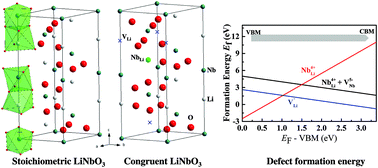Microstructure and defect characteristics of lithium niobate with different Li concentrations†
Abstract
Lithium niobate is a well-known dielectric material and its defect microstructures have shown a huge impact on its acousto-optical, piezoelectric, and electro-optical properties. However, an understanding of the involved defect structures and identification of the chemical composition of lithium niobate are still not achieved due to the lack of sufficient methodologies. In this work, near-stoichiometric and non-stoichiometric lithium niobate powders were comprehensively studied by X-ray diffraction (XRD) and high-temperature Raman and UV-vis spectroscopy. Density functional theory (DFT) calculation was performed to evaluate the defect formation energies, and the XRD patterns of different defect models (NbLi4+, VLi−, NbLi4+ + VNb5−) were also simulated. Our results show that Nb antisites are the most stable point defect that coexist with Li vacancies in congruent lithium niobate samples. The intrinsic point defects induce the Li/Nb cation mixing, temperature-dependent defect microstructures, and disorder in the lithium niobate lattice frame. This study aims at providing an understanding of microscopic defect structures of lithium niobate powders with different Li concentrations and showing the available methods for accurate description of lithium niobate compositions and defect microstructures.



 Please wait while we load your content...
Please wait while we load your content...